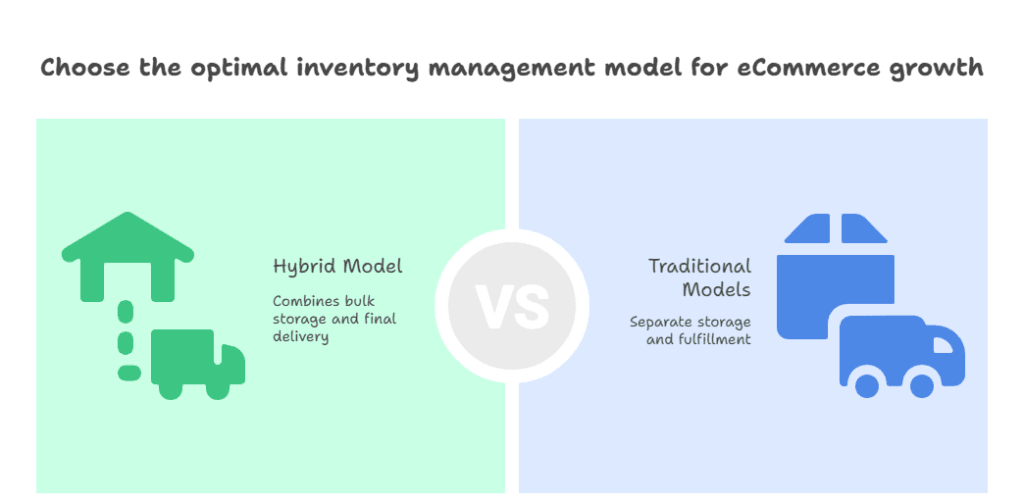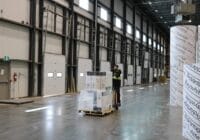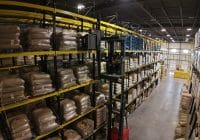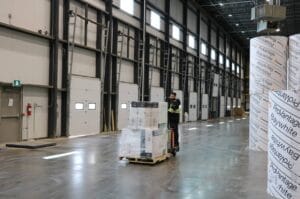If you’re in eCommerce or logistics, you’ve probably seen these two terms used interchangeably: distribution center and fulfillment center. Understanding the differences in the distribution center vs fulfillment center model can save you time, money, and headaches. This guide breaks down the real differences in the battle of distribution center vs fulfillment center.
What Is a Distribution Center?
A distribution center (DC) is a facility that stores products in bulk and ships them to retailers, wholesalers, or other warehouses. It’s built for business-to-business (B2B) operations.
Think of it as a waypoint between manufacturers and stores. If you want to dive deeper into how distribution centers work, we’ve covered it in detail.
Common Uses:
- Restocking physical retail stores
- Supplying regional fulfillment centers
- Supporting wholesale or franchise chains
Key Traits:
- Bulk shipments
- Short-term storage
- Focus on volume and efficiency
- Located near transportation hubs

What Is a Fulfillment Center?
A fulfillment center is focused on business-to-consumer (B2C) operations. Its job? Pick, pack, and ship individual customer orders.
Fulfillment centers handle everything from storing inventory to processing online orders — down to the last detail like packing tape and return labels.
Common Uses:
- eCommerce order processing
- Direct-to-consumer (DTC) brands
- Subscription box services
- Amazon FBA prep
Key Traits:
- Ships to individuals, not retailers
- High order volume, small package size
- Returns processing and customer-facing logistics
- Located close to population centers
Fulfillment Center vs Distribution Center: Side-by-Side Comparison
This visual comparison helps clarify the key operational distinctions in the distribution vs fulfillment center framework.
| Feature | Fulfillment Center | Distribution Center |
| Shipment Type | Individual orders (B2C) | Bulk shipments (B2B) |
| Customer Type | End consumers | Retailers, wholesalers, other facilities |
| Storage Duration | Short-term | Short to medium term |
| Location Strategy | Near customers | Near transport hubs |
| Typical Automation | High (for pick, pack, ship) | Moderate (for pallet movement, sorting) |
| Services Offered | Packing, shipping, returns, customization | Receiving, sorting, cross-docking |
| Best For | eCommerce brands | Manufacturers, wholesalers |
Fulfillment Center vs Distribution Center: Pros, Cons & Use Cases
Let’s break down the benefits and tradeoffs in the fulfillment center vs distribution center decision. Both distribution centers and fulfillment centers have unique strengths — but each comes with trade-offs. Choosing the right one depends on your business model, order volume, and shipping strategy. Here’s a clear comparison to help you decide:
Fulfillment Center: Pros
- Direct-to-Consumer Ready: Designed to handle individual orders quickly and accurately.
- Fast Last-Mile Delivery: Located near customer hubs for faster shipping times.
- Scalable for eCommerce: Easily handles order spikes during holidays or sales.
- Return Management: Most offer reverse logistics, reducing your workload.
- Customer Experience Focus: Options for branded packaging, inserts, and real-time tracking.
Fulfillment Center: Cons
- Higher Cost per Order: You’ll pay more for picking, packing, and personalization.
- Short-Term Storage: Not ideal for holding slow-moving or seasonal inventory.
- Less Control: If outsourced, you rely heavily on third-party accuracy and systems.
Distribution Center: Pros
- Cost-Efficient for Bulk Shipping: Ideal for B2B operations and retail restocking.
- Centralized Inventory: Useful for managing inventory across multiple regions or store locations.
- Supports High Volume: Efficient at moving large quantities of product quickly.
- Integrates with Fulfillment Network: Can feed fulfillment centers for a hybrid setup.
Distribution Center: Cons
- Not Built for B2C: Lacks the systems and workflows for processing small, personalized orders.
- Slower to Adapt: Less flexible in scaling up quickly or pivoting operations.
- Limited Customer-Facing Services: No packaging customization or direct returns handling.
Pro Tip: Many growing eCommerce brands use a hybrid model — a distribution center for storing and moving inventory in bulk, and fulfillment centers for delivering final orders to customers.

Shipment Type & Customer Focus
Fulfillment centers specialize in processing individual online orders for end consumers — ideal for direct-to-consumer (DTC) models. Distribution centers, on the other hand, handle bulk shipments that support business-to-business (B2B) logistics. They’re built for volume and scale, not personalized delivery.
Storage Duration & Inventory Flow
Fulfillment centers are designed for fast-moving inventory — products stay for days or weeks, not months. If items sit too long, you’ll likely face storage fees. Distribution centers can manage stock a bit longer, serving as temporary holding zones before goods move downstream in the supply chain.
Strategic Location Placement
Fulfillment centers are located close to customers to support faster last-mile delivery. This improves shipping times and reduces costs. Distribution centers prioritize proximity to transportation networks like ports, highways, and rail lines to maximize shipping efficiency at scale.
Automation & Operational Focus
Fulfillment centers rely heavily on automated picking, packing, and sorting systems, optimized for processing high volumes of individual orders. In contrast, distribution centers focus on bulk movement of inventory using forklifts, pallet jacks, and moderate automation for tasks like cross-docking or freight routing.
Services Offered: What’s Included?
Fulfillment centers go beyond storage — they offer custom packaging, returns management, kitting, labeling, and even subscription box handling. Distribution centers are more focused on inbound/outbound logistics, receiving inventory in bulk, sorting, and redistributing it to multiple endpoints.

Which One Should You Use? A Strategic Guide Based on Your Business Model
Choosing between a fulfillment center and a distribution center isn’t just about logistics — it’s about aligning your operations with your customer needs, growth plans, and profitability goals. This section outlines which model makes the most sense when comparing distribution center vs fulfillment center for various ecommerce and B2B scenarios.
Use a Fulfillment Center if:
- Your primary business is direct-to-consumer (DTC) through online sales platforms like Shopify, Amazon, WooCommerce, or Etsy.
- You prioritize fast, reliable shipping and want to meet rising customer expectations for same-day or next-day delivery.
- You’re looking to scale quickly without the overhead of running your own warehouse or logistics team.
- Your products are typically shipped in small quantities or individual units, and you require efficient pick, pack, and ship services.
- You want to outsource returns processing, customer-friendly packaging, or value-added services like kitting or personalization.
- You operate in markets with frequent order fluctuations and need a logistics partner that can scale on demand during peak seasons.
Use a Distribution Center if:
- You manage bulk shipments that need to be delivered to multiple retail stores, wholesalers, or other warehouses in a B2B supply chain.
- Your business involves regional or national distribution, and you want to optimize transportation costs and delivery times.
- You’re a manufacturer, wholesaler, or large retailer needing centralized control over your inventory before it moves downstream.
- You require cross-docking, inventory consolidation, or bulk order routing across a wide geographic footprint.
- You store goods that don’t need immediate shipping but must be held in strategic locations for downstream supply chain efficiency.
- You’re building a multi-node logistics network and need hubs to bridge your suppliers, warehouses, and fulfillment partners.
Can You Use Both?
Absolutely. In fact, most growing businesses should. For many brands, using both a fulfillment vs distribution center hybrid model offers the best of both efficiency and speed.
A smart supply chain often looks like this:
Warehouse → Distribution Center → Fulfillment Center → Customer
This setup lets you:
- Store long-term inventory affordably
- Move products closer to where they’re needed
- Ship fast and efficiently to end buyers
Which Model Saves More Money Long-Term?
Fulfillment centers cost more per order but can reduce overhead if you’re just starting out. Distribution centers shine when you ship in bulk, have high-volume orders, or run a physical retail network.
| Scenario | Cost-Efficient Choice |
| Fewer than 500 orders/month | Fulfillment Center |
| Multiple retail locations | Distribution Center |
| Fast-growing DTC brand | Start with Fulfillment Center, add DC later |
| Need long-term inventory storage | Use DC or warehouse + FC combo |
Tip: Don’t just look at unit cost. Consider speed, storage fees, and last-mile delivery.
How to Transition from Fulfillment to Distribution (or Vice Versa)
Test a direct distribution vs fulfillment center approach in a single region before making a full shift.
- Audit your SKUs: Separate fast-moving vs. bulk.
- Use a hybrid model temporarily: Route bulk to DC, active SKUs to FC.
- Update your tech stack: Make sure WMS and inventory systems sync between both.
You can explore solutions like ShipBob’s 3PL software to simplify multi-center logistics.
- Notify your partners: Align timelines across your 3PL, carriers, and platforms.
Pro tip: Start small — test your new setup in one region before rolling it out nationwide.

Common Mistakes to Avoid
One of the biggest missteps is misunderstanding the fulfillment center vs distribution center distinction — leading to increased costs or delayed deliveries.
- Using a distribution center for direct-to-consumer orders.
- Storing long-term inventory in fulfillment centers.
- Assuming all 3PLs are interchangeable.
- Poor inventory forecasting.
- Ignoring returns management.
| Model | Holds Inventory? | Ships To | Best For |
| Fulfillment | Yes | Consumers | Growing eCom brands |
| Distribution | Yes | Stores, Warehouses | Wholesalers, Retail Chains |
| Drop Shipping | No | Consumers | Early-stage or test products |
Quick rule of thumb:
- Drop shipping = no inventory, lower margin, low control
- Fulfillment = fast, scalable
- Distribution = bulk, B2B, cost-efficient
Questions to Ask Before Picking a Fulfillment or Distribution Partner
- Can you support both B2B and B2C?
- What’s your SLA for same-day shipping?
- How do you handle returns or damaged items?
- Do you charge long-term storage fees?
- What happens during peak season?
- Do you integrate with my eCommerce platform?
- What’s your fee structure (storage, pick/pack, carrier markup)?
Bonus: Ask for references in your industry.
How Fulfillment Centers Directly Impact Customer Satisfaction
- In the world of eCommerce, your warehouse is no longer just a backend operation — it’s a core part of your customer experience. Fulfillment centers play a critical role in how fast, accurate, and personalized each customer order is handled.
- Fast Shipping = Happy Customers
- Speed matters. Fulfillment centers are designed to process high volumes of individual orders with lightning speed. Their strategic placement near population centers enables faster last-mile delivery — a key driver of customer satisfaction and loyalty.
- Packaging and Presentation
- A good fulfillment center does more than stuff a product in a box. Many offer branded packaging, custom inserts, gift notes, and more — all of which elevate the unboxing experience. These little touches build brand affinity and increase the chance of repeat purchases.
- Easy Returns Build Trust
- Returns are inevitable, but a streamlined return process can turn a frustrated customer into a loyal one. Fulfillment centers often manage reverse logistics efficiently, handling inspections, restocking, and even customer communication.
- Order Accuracy = Fewer Support Tickets
- With robust warehouse management systems (WMS) and barcode scanning, fulfillment centers can maintain very low error rates. That means fewer incorrect orders, fewer complaints, and fewer support costs for your business.
- Scalable Without Compromising Quality
- As your business grows, fulfillment centers scale with you. Whether it’s handling a seasonal rush or expanding to new regions, a good fulfillment partner ensures you can deliver a consistent, high-quality experience — no matter how many orders you’re processing.
Bonus: Not Sure Which You Need? Ask Yourself This
- Do you ship to customers directly? → Fulfillment center
- Do you ship to retail stores or other warehouses? → Distribution center
- Do you hold inventory long-term? → Warehouse or DC
- Do you need fast last-mile delivery? → Fulfillment center
- Do you ship both B2B and B2C? → Hybrid setup or advanced 3PL
Still Confused About Distribution vs Fulfillment Center?
If you’re unsure whether to focus on distribution vs fulfillment center models, consider your audience — B2B buyers vs direct-to-consumer customers — and order size.
Final Word: Don’t Confuse the Two
If you’re unsure whether to focus on distribution vs fulfillment center models, consider your audience — B2B buyers vs direct-to-consumer customers — and order size.
A distribution center moves bulk. A fulfillment center moves individual orders. If you’re running an eCommerce brand, you need fulfillment — ideally, from a partner who can scale with you.
Choose your logistics partners based on your customer needs. Speed, accuracy, and reliability start with the right kind of facility. Ultimately, the right choice in the distribution center vs fulfillment center decision depends on your order volume, customer base, and growth plans. If you’re scaling, choosing the right path in the distribution center vs fulfillment center comparison can streamline fulfillment and protect your margins.
FAQs
1. Is Wayfair a fulfillment center or a distribution center?
Wayfair uses distribution centers for its bulk inventory and fulfillment centers for customer order processing. It’s a hybrid model.
2. Is Amazon a distribution or fulfillment center?
Amazon operates both. It uses fulfillment centers to ship directly to customers and distribution centers to move goods between warehouses and fulfillment hubs.
3. Can I switch from direct distribution to a fulfillment center later?
Yes, many businesses begin with direct distribution vs fulfillment center shipping and scale into hybrid logistics as volume increases.
4. Fulfillment Center vs Drop Shipping vs Distribution: What’s the Real Difference?
Let’s also explore how a fulfillment vs distribution center strategy compares with other models like dropshipping.



